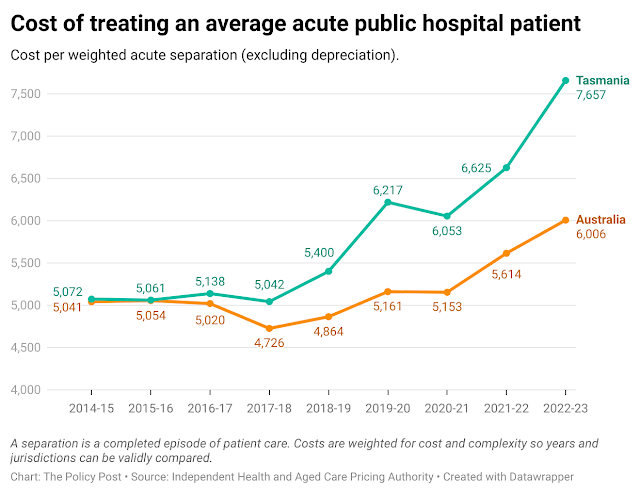One state has the worst hospital
system – and the most expensive.
Inefficient, neglected hospitals cost lives and waste dollars. You don’t always get what you pay for.
Australia’s smallest state has a big budget problem. It also
has the nation’s least adequate hospital system. There’s a relationship between
the two but none of the state’s politicians, from any party, has a clue about
how to fix either.
The government has been spending more than it’s earned for
so long that net debt now accounts for 93% of annual revenue. Revenue is $9.5
billion and borrowings are at $8.8 billion.
According to the state Treasury, borrowings are forecast to increase
to $14.9 billion by 2027-28. That’s 152% of annual revenue. Interest payments
are soaring, predicted to reach $700 million by 2027-28.
That’s a remarkable result for a government which came to
power in 2014 with a policy of ruthless slash-and-burn budget cuts. Saving
money was at the core of the government’s strategies – and no area was as hard
hit as the public hospital sector.
Salaries were cut, staff numbers restricted and – most importantly
– critical capital investment was delayed, abandoned or not even contemplated.
By failing to borrow to fund productive hospital infrastructure, the government
has condemned its hospitals to a double-whammy of overcrowding and
soaring day-to-day costs. Tasmania’s nation-leading inefficiency is driven
almost entirely by a lack of investment in capital. Staff are working harder
and harder and achieving less and less.
When the Liberals came to power in 2014, the cost of
treating an average patient was in line with the national average, both for
acute inpatients and for emergency department presentations. But by 2022-23, it
cost 28% more to treat a given patient in an acute ward than it did in other
states.
The situation in emergency departments was even more
remarkable: up 40%.
The government’s ill-advised attempts to save money has backfired
so badly that the resulting inefficiency has added substantially to the state’s
budgetary problems. By 2022-23, it cost the budget $339 million. And by now,
that figure is likely to be between $400 and $450 million.
All of that accrues to the state. Both the federal government
and the Commonwealth Grants Commission refuse to reward inefficiency, so the Tasmanian
government gets no extra federal health funding and no extra GST to cover these
rising costs. The share of federal health funding, split equally between the Commonwealth
and the state when the government came to power, is now grossly distorted.
There are ways to fix all this. I have some proposed answers,
which all state politicians have ignored. So you can see for yourself in these
two detailed proposals.
The first, analysing the cost issues, can be downloaded here.
The second, a detailed, costed and affordable eight-year plan
to make Tasmania’s hospital system finally fit for purpose, can be downloaded here.





